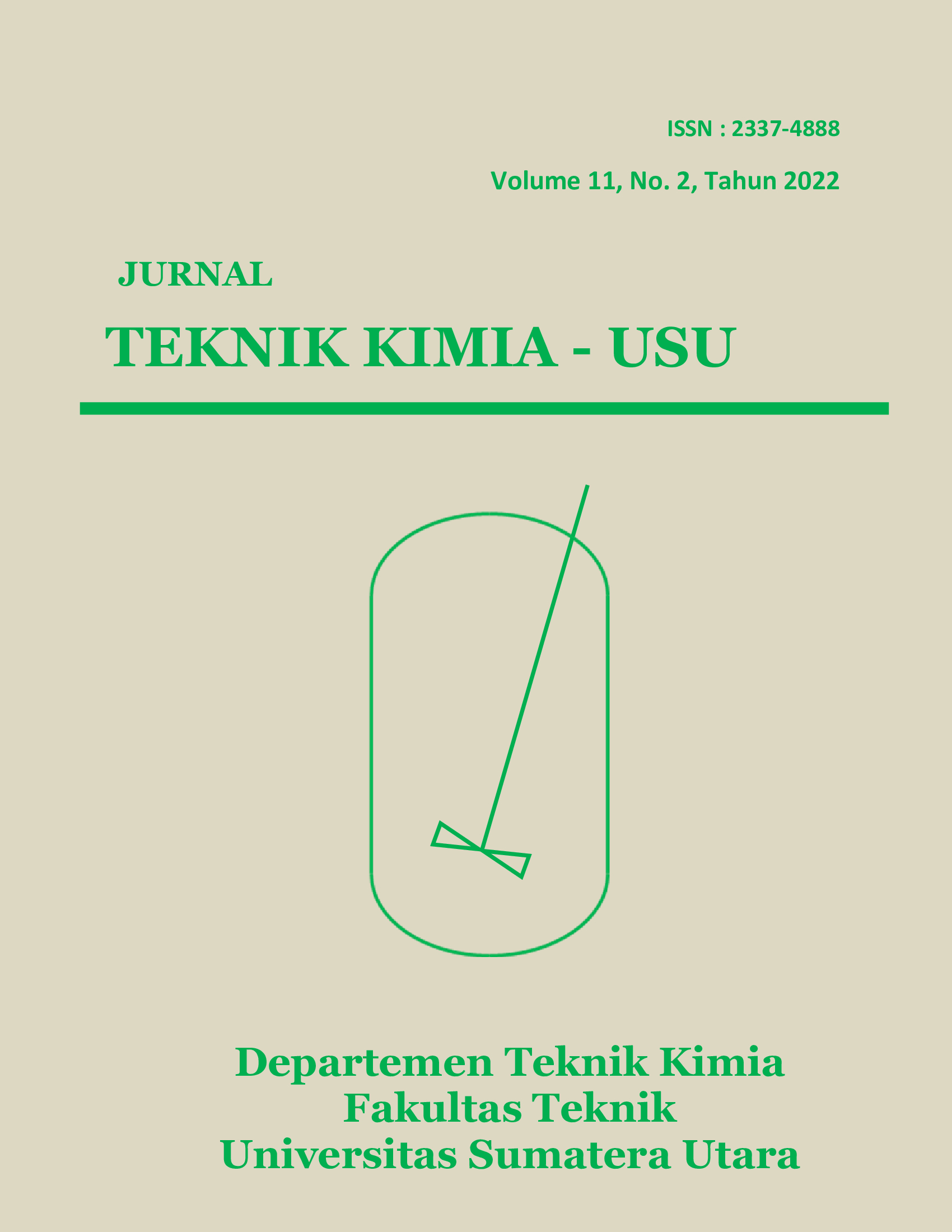Pengaruh Selulosa Nanokristal dari Serat Buah Kelapa Sawit sebagai Pengisi dan Kalium Klorida sebagai Agen Pendispersi Terhadap Sifat Fisik Bioplastik Berbasis Pati Biji Alpukat (Persea americana)
DOI:
https://doi.org/10.32734/jtk.v11i2.9239Keywords:
nanocrystal cellulose, potassium chloride, avocado seed, bioplasticAbstract
This study aims to determine the effect of nanocrystalline cellulose and potassium chloride (KCl) to bioplastics from avocado seed starch and glycerol as plasticizer. In this study, nanocrystal cellulose obtained from palm fruit fiber was hydrolyzed using sulfuric acid (H2SO4) at a concentration of 50%. The starch used in this study was obtained from the avocado seed extraction process. On producing bioplastic, the casting method was used with the addition of nanocrystal cellulose as filler of 1%, 2%, 3%, and 4% (%w), KCl as dispersing agent of 0%, 1%, 2%, and 3% (%w), and glycerol as plasticizer by 30 (%w). Based on the density test, the optimum value was obtained at 2% of nanocrystal cellulose and 2% of KCl with the value around 0.041 gram/cm3. The best water absorption values were 57.1% and 53.8% which obtained at 2% of nanocrystal cellulose and 1% of KCl. Scanning Electron Microscope test results showed uniformly distributed nanocrystal cellulose granules filling the surface of the bioplastic. The addition of KCl as dispersion agent give a good impact.
Downloads
References
Y. Sarkingobir and A. Lawal, “Bioplastics: Their advantages and concerns,” Materials and Metallurgical Engineering, vol. 11, no. 1, pp. 13-18, 2021.
J. B. A. Silva, T. Nascimento, L. A. S. Costa, F. V. Pereira, B. A. Machado, G. V. P. Gomes, D. J. Assis, and J. I. Druzian, “Effect of source and interaction with nanocellulose cassava starch, glycerol and the properties of films bionanocomposites,” in Materials Today: Proceedings, 2015, vol. 2, no. 1, pp. 200–207.
S. Mali, M. Victória, E. Grossmann, and Fábio Yamashita, “Starch films: production, properties and potential of utilization,” Semina : Ciências Agrárias, vol. 31, no. 1, pp.137-156, 2012.
Maulida, T. Kartika, M. B. Harahap, and M. H. S. Ginting, “Utilization of mango seed starch in manufacture of bioplastic reinforced with microparticle clay using glycerol as plasticizer,” in IOP Conference Series: Materials Science and Engineering, 2018, vol. 309, no. 1.
A. Campos, A. R. Sena Neto, V. B. Rodrigues, B. R. Luchesi, L. H. C. Mattoso, and J. M. Marconcini, “Effect of raw and chemically treated oil palm mesocarp fibers on thermoplastic cassava starch properties,” Ind. Crops Prod., vol. 124, pp. 149–154, 2018.
J. Lamaming, R. Hashim, C. P. Leh, O. Sulaiman, T. Sugimoto, and M. Nasir, “Isolation and characterization of cellulose nanocrystals from parenchyma and vascular bundle of oil palm trunk (Elaeis guineensis),” Carbohydr. Polym., vol. 134, 2015.
Anonim, Industri minyak sawit Sumatera Utara berkelanjutan. edisi ke-XII, Bogor: Gabungan Pengusaha Kelapa Sawit Indonesia, Cabang Sumatera Utara, 2016.
S. Silviana and H. Hadiyanto, “Preparation of sago starch-based biocomposite reinforced microfibrillated cellulose of bamboo assisted by mechanical treatment,” in AIP Conference Proceedings, 2017, vol. 1855.
X. Zhang, Y. Yu, W. Li, D. Ren, and H. Wang, “MFC from KCl solution,” Bioresources, vol. 10, no. 4, pp. 6635-6642, 2015.
E. Kamsiati, H. Herawati, and E. Y. Purwani, “Potensi pengembangan plastik biodegradable berbasis pati sagu dan ubi kayu di Indonesia,” Jurnal Penelitian dan Pengembangan Pertanian, vol. 36, no. 2, pp. 67-76, 2017.
I. Gonçalves de Moura, A. Vasconcelos de Sá, A. S. Lemos Machado Abreu, and A. V. Alves Machado, Bioplastics from agro-wastes for food packaging applications, in A. M. Grumezescu, Nanotechnology in the Agri-Food Industry, Volume 7. Ansterdam: Elsevier Academic Press in Food Packaging, 2017.
Anonim, Produksi Buah-buahan di Indonesia, Tahun 2015-2019, Kementerian Pertanian, Indonesia, 2019.
D. Hana Kartika, Mutmainah, and Mufrod, “Pengaruh peningkatan konsentrasi pati biji alpukat (Persea americana mill.) sebagai pengikat terhadap karakteristik fisik granul dan tablet ekstrak akar alang-alang (Imperata cylindrica Linn.),” Majalah Obat Tradisional, vo. 17, pp. 22-26, 2012.
D. Klemm, F. Kramer, S. Moritz, T. Lindstrom, M. Ankerfords, D. Gray, and A. Dorris, “Nanocelluloses: A new family of nature-based materials,” Angew. Chemie - Int. Ed., vol. 50, no. 24, pp. 5438–5466, 2011.
H.-Y. Yu, Z.-Y. Qin, L. Liu, X.-G. Yang, Y. Zhou, and J.-M. Yao, “Comparison of the reinforcing effects for cellulose nanocrystals obtained by sulfuric and hydrochloric acid hydrolysis on the mechanical and thermal properties of bacterial polyester,” Compos. Sci. Technol., vol. 87, pp. 22–28, 2013.
N. Isfa’ni, T. Tundjung, Handayani, Yulianti, and Zulkifli, “Pengaruh pemberian senyawa KCl (kalium klorida) terhadap pertumbuhan kecambah sorgum (Sorghum bicolor (L.) Moench),” J. Ilm. Biol. Eksperimen dan Keanekaragaman Hayati, vol. 5, no. 1, pp. 11-18, 2018.
K. Puspitasari, “Pengaruh penambahan kitosan terhadap sifat fisik dan mekanik film biopolimer dari pati batang kelapa sawit (Elaeis guineensis jack) dengan plasticizer sorbitol,” Skripsi, Universitas Sumatera Utara, Medan, 2015
S. Purnavita, D. Y. Subandriyo, and A. Anggraeni, “Penambahan gliserol terhadap karakteristik bioplastik dari komposit pati aren dan glukomanan,” Metana, vol. 16, no. 1, pp. 19–25, 2020.
G. E. Ayu, H. Nasution, M. Lubis, H. Harahap, and M. T. Al Fath, “The production of nanocrystalline cellulose from oil palm fruit fibers using chemical treatment,” in AIP Conference Proceeding, 2020, vol. 2267.
Anonim, Standard Test Methods for Density and Specific Gravity (Relative Density) of Plastics by Displacement (ASTM D729), ASTM, Philadelphia, 2020, pp. 1-6.
A. Shafqat, N. Al-Zaqri, A. Tahir, and A. Alsalme, “Synthesis and characterization of starch based bioplatics using varying plant-based ingredients, plasticizers and natural fillers.,” Saudi J. Biol. Sci., vol. 28, no. 3, pp. 1739–1749, 2021.
M. Fazeli and R. A. Simão, “The effect of cellulose nanofibers on the properties of starch biopolymer,” Macromol. Symp., vol. 380, no. 1, pp. 1–8, 2018.
R. Ortega-Toro, “Development and characterization of corn starch films by blending with more hydrophobic compounds,” Thesis, Universitat Politecnica De Valencia, Valencia, 2015
J. Shojaeiarani, D. S. Bajwa, and S. Chanda, "Cellulose nanocrystal based composites: A review," Composites Part C, vol. 5, 2021.
Published
How to Cite
Issue
Section
Copyright (c) 2022 Jurnal Teknik Kimia USU

This work is licensed under a Creative Commons Attribution-ShareAlike 4.0 International License.








